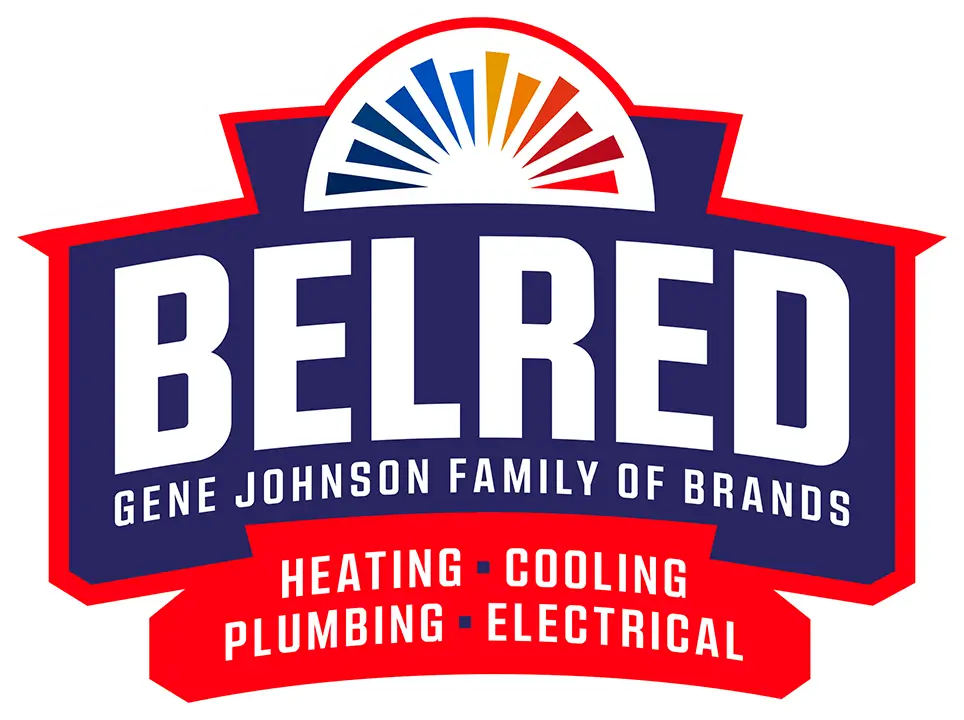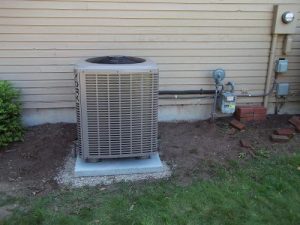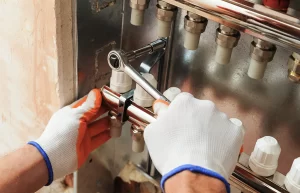Have you tried cranking up the heat and…nothing? Your heat pump’s pulled a no-show, leaving you in the cold (literally!). We’ve all been there – that sinking feeling when you realize you might be dealing with a busted HVAC system. But don’t go running for a heavy coat and space heater just yet!
There could be a simple explanation for why your heat pump has decided to take a day off. Maybe it just needs a little tough love to whip it back into shape. Before you resign yourself to an expensive repair call, let’s troubleshoot this heating hiccup ourselves first.
In this guide, we’re breaking down some of the most common reasons heat pumps like to stop working and play dead. We’ll walk through easy DIY checks any homeowner can handle. The goal is that with one of our quick fixes, you can get that heat flowing again without ever needing backup!
But if those DIY efforts fall flat, don’t worry – we’ll also tell you when it’s time to call in the pros. Sometimes heat pump problems are just too much for an amateur to handle alone. No shame in knowing your limits! Either way, we’ll get you toasty warm again in no time.
Common Reasons Why a Heat Pump Won’t Turn On
Alright, folks, let’s dive into the nitty-gritty of why your heat pump might be giving you the cold shoulder. Buckle up!
Power Issues
Sometimes the reason your heat pump refuses to kick on is as simple as it’s not getting any juice. We’re talking electrical problems like:
Tripped Circuit Breaker
Don’t underestimate the humble circuit breaker’s ability to shut your whole operation down. If it gets overloaded and trips, bam – your heat pump is disconnected from its power supply. Give your breaker box a look and see if you need to reset it.
Blown Fuse
Similar deal with fuses – if one blows in your HVAC system, it can totally cut off the power flow to your heat pump. You might need to locate and replace that burnt-out fuse to get back in business.
Loose or Damaged Wiring
Wiring problems are a sneaky culprit too. If the wiring between your thermostat, heat pump, and electrical panel gets loose, frayed or damaged, it can disrupt that all-important connection. Cue the heating malfunction!
Thermostat Problems
Okay, let’s move on to that other control center calling the shots – the thermostat. When it’s on the fritz, your heat pump has no idea what to do.
Incorrect Thermostat Settings
First things first, let’s make sure you haven’t accidentally set your thermostat to the wrong mode. If it’s stuck on cooling instead of heating, well, no wonder that heat pump ain’t firing up!
Low or Dead Thermostat Batteries
Here’s another dumb mistake we all make – letting those thermostat batteries run down. When they’re dead, the thermostat has no way to communicate with the heat pump to turn it on and off. Easy fix!
Thermostat Calibration Issues
But say the settings and batteries check out. An improperly calibrated thermostat could still be giving your heat pump all the wrong signals about the actual temperature, leaving it clueless on when to kick into gear.
Blocked or Dirty Air Filters
Cue the heavy breathing and wheezing -air filter issues can leave your heat pump gasping for air. Literally.
When those filters are clogged with dust, pet hair, and who knows what else, it restricts the airflow. To prevent overheating, your heat pump will just shut itself down or refuse to turn on in the first place.
Outdoor Unit Problems
Of course, sometimes the indoor air handler isn’t the issue – it’s what’s going on outside that’s cramping your heat pump’s style.
Frozen or Blocked Outdoor Unit
If your outdoor unit is buried under leaves, dirt, or ice buildup, good luck getting that thing to function. That blockage needs to be cleared ASAP for the heat pump to do its thing.
Fan or Motor Issues
But say you’ve cleaned off the outdoor unit and it still won’t cooperate. There could be an internal fan or motor issue preventing that outside component from operating. At that point, you’ll likely need a professional set of eyes on the situation.
Refrigerant Levels
Last but definitely not least, let’s talk about the heat pump’s life source – refrigerant. This stuff is crucial for the whole heating and cooling process.
Low Refrigerant Levels
When refrigerant levels get too low, it can prevent that heat transfer from happening. As a protective measure, your heat pump may just shut itself down to avoid getting damaged from the lack of refrigerant.
Signs of Refrigerant Leaks
The big issue here is usually leaks. If you’re hearing hissing noises, getting poor heating or cooling performance, or spotting any ice buildup, those could be signs of a refrigerant leak. Unfortunately, this requires calling in professional backup to handle that hazardous refrigerant. Trying to mess with those refrigerant lines yourself is just asking for trouble.
So there you have it – the big reasons why your heat pump might have stopped working. From power problems and thermostat issues to airflow restrictions and refrigerant woes, there’s a lot that can potentially go wrong.
The good news? Many of these problems are relatively easy for savvy homeowners to check themselves.
Troubleshooting Tips for Homeowners
Okay, DIY warriors, it’s time to get our hands dirty! There are some basic troubleshooting steps any homeowner can tackle first before waving the white flag. Let’s run through them:
Step 1: Check the Power Supply
First thing’s first – let’s ensure your heat pump is actually getting its juice. Do a quick check of your circuit breaker or electrical panel. See if the breaker controlling the heat pump has tripped and needs to be reset.
While you’re at it, ensure the pump is firmly plugged into a working outlet or hardwired connection. Sometimes the simplest power problems are the culprit!
Step 2: Inspect Thermostat Settings
Assuming the power is properly flowing, it’s time to turn our attention to that control center calling all the shots – the thermostat. Double, triple check that you have it set to “Heat” mode and your desired temperature is higher than the current room temp. It’s an easy setting to miss!
Oh, and don’t forget to change those batteries if they’re running low. Dead batteries = a thermostat that can’t communicate with your heat pump.
Step 3: Clean or Replace Air Filters
Still no luck? Air flow could be the issue. Those filters are the lungs of your HVAC system. When they get clogged up with dust, pet hair and general grime, they restrict that airflow like a bad head cold.
Locate your indoor air handler and inspect those filters – if they’re looking grimy, carefully remove and replace them with fresh new ones. Most models make it pretty easy for homeowners to swap them out.
Step 4: Clear Debris from the Outdoor Unit
Okay, say you’ve tackled all the indoor components but your heat pump still won’t fire up. Time to go investigate that outdoor unit! Carefully clear away any leaves, dirt, snow or ice that may have accumulated on or around it. Just be gentle – you don’t want to accidentally damage those delicate fins or mechanisms.
Step 5: Listen for Unusual Noises
If you’ve gotten this far in your DIY troubleshooting with no success, it’s time to put on your detective hat and ears. Weird grinding, screeching or hissing noises coming from your heat pump could be clues that something more serious is going on – like a mechanical or refrigerant issue.
As much as we hate to say it, any strange sounds like that are likely an indication that it’s time to call in professional backup for a closer inspection.
There you have it – a simple checklist any homeowner can run through to try and get their heat pump back in working order. But remember, don’t go playing hero too long if the troubleshooting hits a dead end. Knowing when to call in the HVAC experts is key to getting that heat back up and running smoothly again!
When to Call a Professional
As much as we all love feeling handy and self-sufficient, there comes a point when it’s time to accept defeat and call in the big guns. We’re talking licensed HVAC professionals, folks! Here’s when you know it’s time to throw in the towel:
Persistent Issues After Troubleshooting
Let’s say you’ve diligently worked through all the basic troubleshooting tips – checking the power supply, thermostat settings, air filters, you name it. And yet, that stubborn heat pump still refuses to turn on or keep running properly.
As frustrating as it is, continuing to bash your head against the wall won’t solve anything. If those simple fixes didn’t do the trick, it’s time to call in professional reinforcements.
Electrical or Wiring Problems
While we’re on the subject of power issues, let’s be crystal clear – any electrical problems or wiring faults are an absolute no-go zone for amateurs. It doesn’t matter how confident you feel, trying to mess around with live wires or circuits yourself is just begging for a safety disaster. Shocks, fires, you name it.
If your heat pump troubles seem to be originating from the electrical panel, wiring, or circuit breakers, don’t risk it. Hire a certified pro ASAP.
Refrigerant Leaks and Repairs
Similarly, anything involving refrigerant is off-limits for DIYers. That chemically cooled substance that makes your whole heating and cooling system possible? It’s not something you want to be inhaling or mishandling.
Only trained HVAC technicians with the proper licensing and equipment can safely test for leaks, repair refrigerant lines, and recharge the system. Don’t even think about trying to DIY those kinds of repairs!
Major Component Failures
Let’s say your heat pump is powering on, but then immediately shuts back off. Or maybe it’s running but providing little to no actual heat. Those are potential signs of some heavy-duty internal component failures, such as compressors, blown capacitors, busted fan motors, and the like. In other words – waaaay beyond a homeowner’s capabilities.
You’ll need to call in a professional technician to properly diagnose and repair (or likely replace) those complex inner workings.
While basic heat pump troubleshooting is DIY-able for many homeowners, some issues are just too big, complex or downright dangerous to handle alone.
Don’t Get Left Out in the Cold – Call BelRed!
We’ve covered all the bases – from funky thermostats to clogged filters and refrigerant woes. While a little DIY heat pump troubleshooting is admirable, at some point it’s wiser to call in the pros. Whether you’ve hit a dead end or suspect a bigger electrical or mechanical issue, don’t stay shivering!
Save yourself the headache and dial up the heating experts at BelRed. Our team has the tools and know-how to get that heat flowing again quickly and safely. No heat pump is a match for our skills! Dial (855) 345-6161 to schedule service before that cold front hits.







